In This Issue:

By Jerry Hamon, TPWD Area Chief and Chairman TPWD Freshwater Fisheries Advisory Committee
It has recently been brought to my attention that a lot of folks are not familiar with the changes to the Toyota Texas ShareLunker Program and how important it is to teach this to anglers. In January 2018 TPWD rolled out the new and improved version of the program.
So, what changed?
- The ShareLunker program is now year-round, starting on January 1st and ending on December 31st. (Legacy Lunkers are now January through March.)
- There are 4 categories to which anglers can submit their catch.
- Catches can be submitted from the location where the fish was caught via the ShareLunker App over a handheld phone and only one needs to be taken to a certified scale.
So how does it work? The categories are as follows:
|
Lunker - 8+: Bass for this category can either be submitted as a picture of a 24-inch fish on a ruler (mouth fully closed and tail pinched) OR a picture on a digital scale showing 8 pounds to 9.99 pounds. |
|
 |
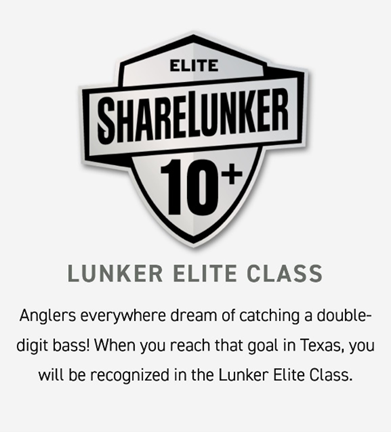 |
|
Lunker Elite - 10+: This category is for bass that are 10 pounds to 12.99 pounds. These are submitted via the app with a picture of the fish on a digital scale. |
Lunker Legend - 13+: This category is for those bass that are 13+ pounds that are not submitted OR they are caught between April - December, (which is outside of the spawning period of January - March). |
|
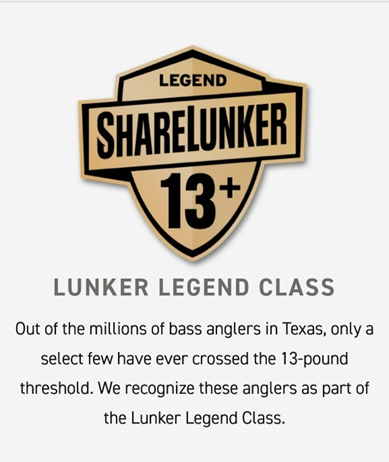 |
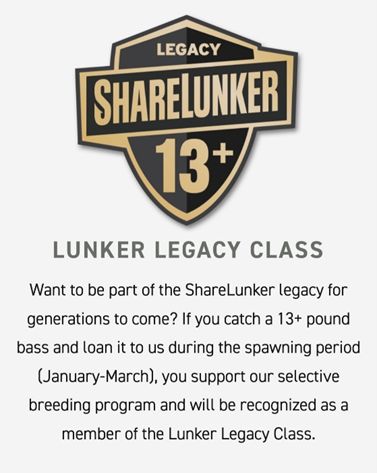 |
|
Lunker Legacy Class 13+: This category is for those bass that are caught from January 1st to 12:00 midnight on March 31st and are shared with the program for spawning and release after the spawn so that data can be gathered regarding the genetics of the fish. The fish are returned to the lake where they were caught so that the angler who caught them may release them. IMMEDIATELY CALL OR TEXT (903) 681-0550 |
Have the changes made it better, and how?
The Toyota ShareLunker program reports on their collection season. See the ShareLunker Archives.
- 24 Legacy-Class ShareLunkers this season, the most during January through March since 1995 (27)
- Nine different waterbodies produced ShareLunkers in 2022
- Lake Daniel became the 75th public waterbody to contribute a Legacy-class ShareLunker
- Four entries were new lake records (Lake Daniel (twice), Eagle Mountain, and O.H. Ivie)
- The new O.H. Ivie waterbody record was set at 17.06 pounds, was the biggest in 30 years, and is the 7th largest largemouth bass ever verified in Texas (private or public)
- Four fish made the Texas Top 50 biggest largemouth bass of all-time list
- For the third season in a row, an angler submitted two entries (back-to-back seasons from O.H. Ivie, and 2020 from Alan Henry)
- Two anglers submitted a catch in back-to-back seasons
- Two ShareLunkers were submitted in the same day, three times this season *
- One angler, Josh Jones, became the first to contribute a fourth ShareLunker to the program
- Five entries were greater than 15-pounds, including three over 16-pounds
- O.H. Ivie reported the most Legacy Class ShareLunkers this season with 12 entries.
Why does it work?
Now, any person, anywhere in Texas, can catch a big bass, log into the ShareLunker App, and submit their catch. They no longer need to have a big boat with a live well to keep the fish alive until they can get it to a certified scale. A huge driving force behind the change was the ever-evolving kayak fishing community, who for years have been hosting “catch, photograph and release” (CPR) tournaments. Another consideration the update committee considered, was the popular High School Fishing Team Tournaments throughout the nation. Then, there’s the average guy who fishes from the bank or a pier. Taking in to account all those things, it just made sense that the program needed some tweaking.
My challenge to Angler Edu Instructors is to make folks aware of the ShareLunker program and the different levels, share the link to download the app and let’s see those big ole 8+ lb. or 24” long Texas bass!!!
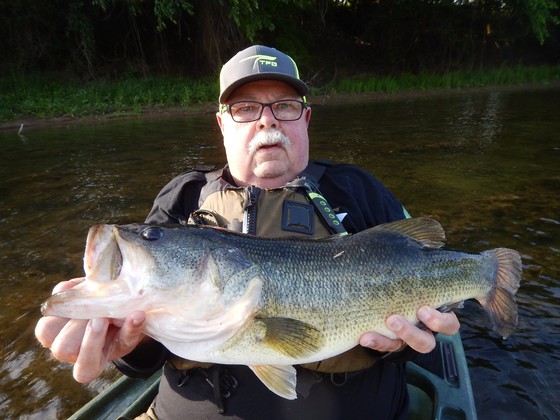 (Photo courtesy of Jerry Hamon)
Back to Top
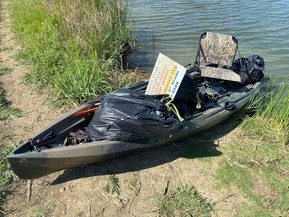
By Russell Husted, TPWD Fly Fishing Instructor, Texas Council FFI Conservation and Social Media Director
A quick testimony about a fishing adventure, that turned into a conservation project I had a couple weeks ago. A friend and I fished at an urban lake here in the DFW area. We had such a great time and caught a good amount of bass. (Photo courtesy of Russell Husted)
It is such a scenic, urban area and while we were there, we saw beavers, wild birds, and a coyote. However, I could not get past the overwhelming amount of trash around the lake. It was awful! That night, I could not get that out of my mind. So, the next morning, I gathered up my trash pick-up gear and went back to the area.
It was very rewarding for me to do this, as conservation has always been a part of me, dating back to my scouting days. Growing up in scouts, and then successfully becoming an Eagle Scout, I was always involved in some sort of conservation effort. This still is a part of me, as I have helped in many conservation projects around the state. Trinity Trash Bash, Brushy Creek Cleanup, Brazos River Cleanup, to name a few. I recruited some friends, and we returned this area back to where it should be – green and gorgeous with NO TRASH!
However, we all know this is a temporary fix. If we don’t dig into the root/cause of the problem, the problem will return. As the new Conservation Chairman for the Texas Council of Fly Fishers International, it is easy to see now more than ever, conservation needs to be at the center of our lifestyles. Urban areas are now seeing a tremendous upswing in use as gas prices soar to new, higher levels. For many of us, long distance fishing trips are now trips to the local pond or lake. With this new surge of traffic, our urban areas are getting pretty beat up, due to poor conservation behaviors.
Did you know you can report someone who litters? Simply take down the following information—license plate number, make and color of vehicle, date and time, location, who tossed the litter (driver, passenger or truck bed), and what was tossed and report it to TxDOT on their easy to use online report system. Upon receipt of the report, TxDOT will compare the information through the Department of Motor Vehicles registration database, and when an exact match is located, will send the litterer a “Don’t mess with Texas” litterbag along with a letter reminding them to keep their trash off our roads. A great way to get the point across and hopefully change the behavior.
It will take more than just that. The council has plans to adopt this area and make it a priority to keep the area clean. We are also partnering with the community on future events, meeting with them to discuss additional conservation best practices to encourage others to do the right thing, and hopefully set an example for their children. Yes, it takes a lot of effort to be conservation minded and make a difference, and we all have a choice to do so or not. Check out the Trash Timeline activity on the instructor page to teach people about how fast things decompose in the world, and help them understand the impact they are making when they litter or use plastic.
So, let’s do our civic duty to help keep Texas areas clean!! Can you recruit some volunteers to help pick up litter, join a local clean-up event, or even adopt an aquatic area near you?
Remember, conservation is so much more than just a litter problem. Texas has water issues, recycling improvement is needed and so much more. Why not see what you can do to help keep Texas, Texas!! Take the pledge. I just did.
Thanks for taking that next step, teaching others and helping to Keep Texas Beautiful!
|
 |
(Photo courtesy of Russell Husted)
Back to Top

by Dr. Cynthia Fox Holt, TPWD Inland Fisheries
Hyperpigmentation/melanosis, aka Blotchy Bass Syndrome (BBS) is the occurrence of black ink-like spots on the skin of freshwater bass species. The first documented observation of BBS occurred in the early 1980s on Largemouth Bass and Smallmouth Bass. Since then, BBS has been officially documented in 18 states and needs to be verified in an additional seven states (see table below.)
|
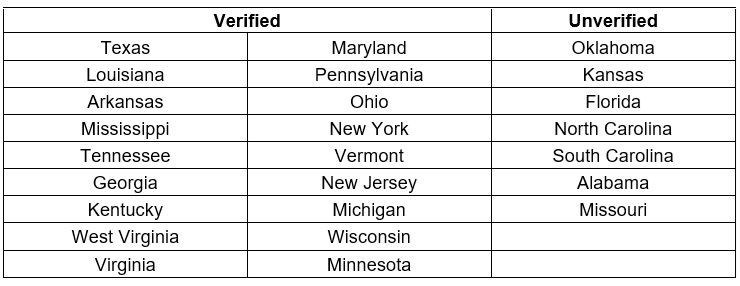
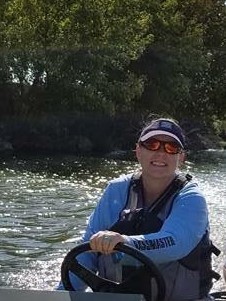
As students and professionals, we have been told it was due to sun exposure or stress related to fishing, temperature, or pollution. Many of us have shared this information with anglers for years. And sometimes, that is the case. But the USGS and USFWS are looking at these bass because some have been found in poor condition and they have found that the spots have also been associated with a specific virus family. Not all blotchy bass have viruses, but a significant number have had at least one of these viruses, and some have had multiple.
(Photo courtesy of Dr. Cynthia Fox Holt)
While the hyperpigmentation on these fish is associated with a virus, these fish routinely appear to be in great condition and are actively feeding. Just like humans and other animals, fish can carry bacteria and viruses that do not cause sickness. The viruses that are associated with BBS have never been identified in humans or common domestic pets (dogs, cats, birds). As such, they are safe to touch to remove the hook and release. They are also safe to eat as long as they are properly cooked.
How the virus spreads between fish is currently under investigation. USGS scientists are researching how the virus reproduces and is transmitted. In any case, anglers should never move fish between water bodies. It is unlawful to place any game fish into public waters other than the body of water where the fish was caught.
So, the goals of the project are to map the distribution and prevalence of blotchy bass. In other words, does it occur more in reservoirs than ponds? Or is it found mostly in larger or smaller fish? Then, try to determine if the virus negatively impacts individual fish or populations. Does it impact survival or growth? If it does negatively impact fish, then they will try to determine a cause. This project isn’t meant to scare anglers or prevent people from fishing. Quite the opposite. Researchers want to learn more to make sure fish populations remain healthy.
Please report bass with Blotchy Bass Syndrome (BBS).
If anglers catch any bass (Largemouth, Smallmouth, Spotted or Guadalupe) with irregular spots that they think could be BBS, we ask that they report the catch to Texas Parks and Wildlife. Please email the following information to Cynthia Fox Holt at Cynthia.fox@tpwd.texas.gov
- Photos of the entire fish showing the blotches
- Name of waterbody OR county name and type of waterbody (reservoir, pond, or river)
- Number of bass caught during that fishing trip (with or without BBS).
|
Back to Top
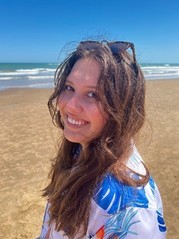
Alondra Fleming-Parra, Austin
Hello! I’m Alondra Fleming-Parra and I’m from Port Isabel, TX. I’ve been fishing for as long as I can remember in the bay of South Padre Island, TX. Along with fishing, I love to hike, cook, take care of my plants, and discover new music. I have a Blue Heeler/Border Collie named Marley who is the biggest lovebug the Earth will ever know. Since I grew up on the coast, I always visit the beach when I can and go fishing with my father.
I just finished my second year at the University of Texas at Austin and currently study Plant Biology. I have a strong passion for the environment and this passion led me to choose to intern with TPWD. I want to explore more in this field and am excited for the networking opportunities to get insight in many career fields.
Being outdoors and connecting with the environment around me has always been a deep passion of mine. I hope to continue to deepen that and share my love with others through education and leadership.
(Photo courtesy of Alondra Fleming-Parra)
|

Taylyn Hickerson, Houston
Hello, my name is Taylyn Hickerson, I am a junior Animal Science Pre-Vet major at West Texas A&M University. I also play football (that's me on the left).
My agriculture journey began in 4-H and FFA where I learned the importance of our environment and natural resources. I have worked and volunteered at countless animal rehabilitation centers in the Houston area, including the Houston SPCA, VCA Stafford Oaks Animal Hospital, and many more.
For my future veterinary practice, I plan to start in livestock, then go back to school and conduct research on an endangered species in a foreign country.
I am a cowboy that grew up in the city. I love being outdoors, going on trail rides,
and animals, sometimes more than people. I know that the road to my achievements is long and has many challenges, but perseverance is the key. I know that Texas Parks and Wildlife will provide valuable experience and also give me a chance to give back to my community. I’m so excited to be part of the team!
(Photo courtesy of Taylyn Hickerson)
|
Back to Top
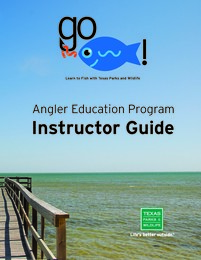
by Karen Marks, TPWD Aquatic Education Manager
What were you doing 30 years ago? A few folks here at TPWD were hard at work establishing the Aquatic Education Program that included Angler Education. The July issue of the TPW magazine has a feature article about the program. A historical timeline outlining major accomplishments is also available on our webpage. Here’s to the next 30 years!
More big news! Our Instructor Training Guide has been updated and the new version is now available online; print copies will be distributed at future instructor training workshops beginning in July. We will send a copy to all active Instructors this fall with the annual incentive mailout. The new version is designed for both the novice and avid angler. While some volunteers may be avid anglers, they may not have lots of teaching experience, likewise… some volunteers may have years of teaching experience but are new to fishing.
The skills are still the same (equipment, casting, knots, tackle assembly, fish ID and habitats, safety, regulations, ethics, and stewardship). But each skill/activity has been expanded to include additional background information and additional activities and resources, to better support our volunteer instructors. Examples of completed supply orders and reports are also included in the guide – to obtain the most current blank supply order or report copy, you will need to download those from the website. Of course, we hope that you will always take the opportunity to report your classes and events online.
When ordering supplies please submit your orders at least three weeks in advance to allow our small and busy team ample time to fill your order.
In June, a third of our current Area Chief volunteers met for the first time in-person in two years. This was our 20th annual meeting! The first meeting was held at TPWD headquarters with four people in attendance. My, how we have grown! At this year’s meeting, we reviewed the new Instructor Guide and even put on our “fed eyes” so we could “audit” simulated reports and learn how to properly fill out a report. We really appreciate everyone’s efforts to report on time and accurately. The current report policy is available online – be sure to take some time to review it. Our program would not be a success without YOU!
If you are interested in becoming an Area Chief (a train-the-trainer certification), and meet the minimum qualifications, please reach out to your regional training specialist (Greg Akins, Keira Quam or Adam Comer) to express your interest. The minimum qualifications include conducting at least one class/event as “Lead” and documentation of a minimum of 25 volunteer hours reported online during the past year.
As we mentioned in our Winter issue, we are in the process of launching a School Pilot Tackle Loaner Program that will provide a basic fishing kit and tackle to Title 1 (K-12) schools and college campuses that are designated as a Historically Black College or University or a Hispanic Serving Institution We plan to start with nine campuses (3 in each of the larger metro areas of Houston, Dallas/Fort Worth and Austin/San Antonio/Rio Grande Valley). The goal is to encourage families and young adults to explore the leisure recreation sport of fishing and hopefully create a lifelong recreation hobby. If you work at a campus and are interested in becoming a host site, please contact us at AnglerEdu@tpwd.texas.gov
Thanks to everyone who supports the sport of fishing and our Angler Education program, especially those teachers who have continued to include angler education in their classes, especially during these trying times. Have a safe and wonderful summer.
|
Back to Top

by Blake Beatty, TPWD Angler Ed. Instructor
Water is the most powerful force on Earth. That’s easy to see as it runs its way through the landscape carving and polishing the stones it touches. But when water isn’t moving and reshaping our environment, it’s easy to forget just how powerful and dangerous it really is.
Be sure to convince your participants to wear a lifejacket and respect the water. Texas law requires that in addition to a sound making device like a whistle, every vessel has one life jacket for each passenger and every passenger under 13 years of age must wear a lifejacket. Accidents and changing water and weather conditions happen at the most unexpected time, always be prepared for the worst, but hope for the best.
Let’s talk about how to be safe on the water. To start, I am an avid kayak angler. I spend more time in my kayak than anywhere else. I first got into the sport in 2018 but my dad and I would fish out of a 16-foot canoe when I was growing up. We always had the low-cost lifejackets that were used more as seat cushions than anything else. When I first looked into fishing kayak tournaments, I noticed they required anglers to wear a lifejacket at all times. My initial thought was, I can swim. But then I thought, what if I get separated from my boat and can’t reach the shoreline? Or I get knocked out? So, I just got into the habit of wearing one every time I went out. Eventually, it got to the point I never notice it unless I’m not wearing it. When speaking to your students, there’s going to be at least one of them that says they can swim. Just tell them yeah, most of us can swim, but the water will test just how long you can swim. It’s best to not let it. Another really good thing to convey to your students is the cost of a lifejacket. Some are expensive and the inflatable type are a lot more comfortable than the inexpensive orange ones (Type II). What people need to remember, is to spend as much as you need to get one comfortable enough that you will wear it! A good video to watch that reminds us of the importance of wearing a life jacket was published by TPWD. Check out “Never Happens”.
With the boom in fishing kayaks, I see more and more people out on the water enjoying themselves. Which is incredible and beautiful. The more people enjoy the outdoors, the more they learn the importance of taking care of it and the more likely the outdoors will be there for everyone else to enjoy.
One thing that also worries me is that people aren’t made aware of the weight ratings on kayaks. People don’t realize, the max rating seen on a kayak is how much it can handle before it sinks. What I believe is the most important specification for a student, or someone else new to kayaking is the self-bailing weight limit. This isn’t advertised as often as it should be and it’s the information a new kayaker really wants to focus on. The self-bailing weight limit is how much weight you can put in the kayak without water coming through the scupper holes. In simpler terms, how much weight before water that comes in doesn’t go back out. For most kayaks, it is 50 lbs. less than the total max weight of the boat. For example, if a kayak has a weight limit of 450 pounds it could very well only hold 400 pounds before you need scupper plugs to keep water from coming inside, that includes a person’s weight and their gear. Be sure to explain to students that in rough conditions if the scupper holes are plugged due to extra weight, the water that comes into the kayak, will not drain out. Know your vessel capacity.
The best way to find the self-bailing weight limit is to ask around on social media if someone else has the model kayak they’re looking for. They will be able to tell how much weight they can put in theirs. I have to add, that putting too much weight in a kayak is a recipe for disaster. I’m speaking from experience here. I overloaded my first kayak so much it barely floated. It was tippy and definitely not safe. Don't overload your vessel.
Knowing these safety tips and teaching them to others can help us all enjoy a safe trip on the water!
(Photo courtesy of Blake Beatty)
|
Back to Top
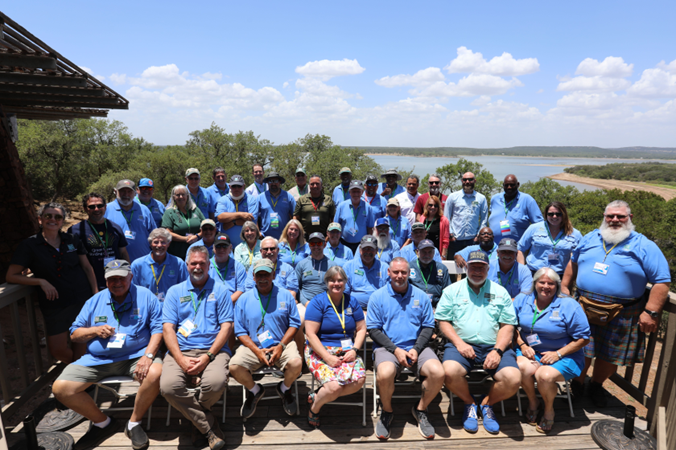 (Photo courtesy of Jason Mercer, TPWD)
The 20th annual Angler Education Area Chief meeting was held June 22-24, 2022 at Canyon of the Eagles on Buchanan Lake in Central Texas. Thirty-three Area Chiefs attended, including 3 new Area Chiefs. Please join us in welcoming our newest Area Chiefs: Mauricio Gonzalez from the Central Tx region, Jonathan Gay and Michael Robinson from the Houston region.
The meeting kicked off with guest speakers Johnnie Smith, Outreach and Education Director; Mischelle Diaz, Communications Division Director; Craig Bonds, Inland Fisheries Division Director; and Burnet County Game Warden Braxton Harris. We also revealed the newly revised Instructor Guide.
A panel discussion about the 30-year history of the Aquatic Education Program with special guests Steve Hall (current Hunter Education Manager), Nancy Herron (retired, former Outreach and Education Director), Ann Miller (retired, former Aquatic Education Manager) and Cappy Smith (retired, former Aquatic Resources Education Coordinator and Aquatic WILD Coordinator) was informative and fun. The success of our program is due in part to the vision and wisdom of these leaders. Read more about the program history on our webpage.
Next, we paired up the new Area Chiefs with the experienced Area Chiefs in small groups to plan mock Instructor workshops. All the groups did a great job with their presentations and shared neat ideas for icebreakers and different ways to teach fishing to new instructors, including online workshops.
Due to the low lake levels, our evening boat ride was cancelled, but some our talented Area Chiefs stepped up to provide delightful evening entertainment including a magic show by Michael Thomas (Houston region) and fish music by Ted Moore (Lubbock region).
The meeting concluded with an awards presentation. Four Area Chiefs earned the topmost award, the Diamond Award, for training 500 plus new instructors over time (cumulative from year to year.)
If you are interested in becoming an Area Chief (a train-the-trainer certification), and meet the minimum qualifications, please reach out to your regional training specialist (Greg Akins, Keira Quam or Adam Comer) to express your interest. The minimum qualifications include conducting at least one class/event as “Lead” and documentation of a minimum of 25 volunteer hours reported online during the past year.
Back to Top
Welcome New Instructors!
Area Chiefs and staff certified 203 new Instructors from January to June. Check out our website to view the list of new instructors.
Be sure to tag us in your event photos on Instagram with the hashtag #GoFishTexas or post on our Facebook page, Texas Parks and Wildlife - Texas Angler Educators.
 Photo of new instructors from Lake Houston Wilderness Park, taught by TPWD Angler Ed. Area Chief, Michael Scherer. (Photo courtesy of Michael Scherer.)
Back to Top
Angler Education Program | Texas Angler Educators Facebook
Learn to Fish Videos | Texas Aquatic Science | TPWD Fishing Information
Volunteer Portal | In Memoriam | Staff Contacts
Angler Education Instructor Workshops, Fishing Events, Fly Fishing Events, Texas Freshwater Fisheries Center, Sea Center Texas
|